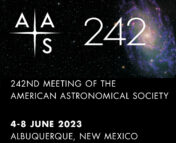In this series of posts, we sit down with a few of the keynote speakers of the 243rd AAS meeting to learn more about them and their research. You can see a full schedule of their talks here, and read our other interviews here!
Professor Jamie Bock is Professor of Physics at Caltech, and a Senior Research Scientist at JPL. Professor Bock’s group designs and builds experiments for fundamental tests of cosmology.

Procrastinating into Cosmology
Prof. Bock came to cosmology only at the end of his PhD. At Berkeley, he wrote his thesis on sounding rocket observations of carbon emission in the diffuse interstellar medium (ISM), where he also helped develop the instruments used to make these observations. While he was writing his thesis, physicists Prof. Paul Richards and Prof. Andrew Lange were studying the anisotropy of the cosmic microwave background (CMB) with competing balloon missions, hoping to measure the geometry of the universe. “To distract me from that task (thesis writing)” Bock says, “I got involved in developing detectors for BOOMERanG” (Prof. Lange’s experiment). These new bolometers (which could be made incredibly sensitive) also ended up on Prof. Richards’s MAXIMA experiment. Eventually, both missions were smashing successes, and both found evidence for a flat universe! Bolometers like these continued to be critical for experimental cosmology missions, such as the Planck satellite and Prof. Bock’s more recent experiments like BICEP, now focusing on measuring the polarization of the CMB.
Challenging Architectures
The CMB polarizations result from different processes, either density fluctuations (E-modes) or primordial gravitational waves (B-modes). In the early 2000s, there were two main competing strategies to measure the CMB polarization and probe inflation models. Most of the field decided to build bigger telescopes in order to measure both the E- and B-modes, but Bock and his collaborators decided to only focus on the B-modes, which only needed smaller telescopes. This allowed them to control the systematic error of their instruments much more effectively than the large telescope teams, and the success of this approach has been borne out in successive generations of the BICEP architecture, culminating in the BICEP array. It hasn’t all been smooth sailing, though. The second generation of the BICEP instrument made (gravitational) waves when the collaboration announced initial evidence of the B-mode polarization in the CMB. This ultimately didn’t last long, as re-analysis of the data indicated cosmic dust was the true source of the signal. “At the time, the only information that we had available to us was our own data and models”, Bock remembers. “You need to have really good measurements of the dust polarization.” A decade or so later, with a much better understanding of potential confounding signals, Bock is excited. “We’re at the stage now of actually ruling out fairly popular models of inflation. This long quest is now yielding fruit.”
New Missions
Bock is also the PI of SPHEREx, a near-IR all-sky mapping mission scheduled for launch in 2025. Bock says that “we’re hitting the golden age of large-scale structure surveys.” SPHEREx’s imaging strategy differentiates it from other cosmology missions, though. “We have a somewhat novel way to measure redshifts.” Bock explains. “You put a linear variable filter on top of the detector, and then measure the sky at different positions. Each of those measurements gives you an observation of the source at different wavelengths. It’s a very efficient way to do spectroscopy if you’re fixed on doing the whole sky as opposed to individual sources.” This spectrophotometry, collating many images in different spectroscopic filters to assemble a low-resolution spectrum, has long been used in planetary science and exoplanet astrophysics, but SPHEREx will be the first large-scale application of this technique for cosmic mapping. In addition to probing the non-Gaussianity of random fluctuations amplified by cosmic inflation, SPHEREx will also do “intensity mapping”, looking at galaxy clustering in the celestial sphere and in redshift. These measurements, especially in SPHEREx’s deep fields, will uncover currently-hidden mechanisms of galaxy formation and evolution.
The Next Generation
When asked about what advice he wished he might have been given as a student, Prof. Bock replied “I had a wonderful advisor when I was in graduate school.” However, regarding current students, he emphasizes that “there’s a general boldness to try these difficult things. Sometimes you don’t know the answer, how well things are going to work out at the end… it’s going to require a lot of your life to make something actually succeed. [Have] a nose for what would be exciting, what would be the possibilities… sit back and think about where things are going and what would be a unique type of contribution.”
Professor Bock’s plenary talk will be on Wednesday, Jan. 10, at 3:40 PM, in Great Hall A of the Ernest N. Morial Convention Center.
Astrobite Edited by: Sahil Hegde
Featured Image Credit: Jamie Bock/Caltech



